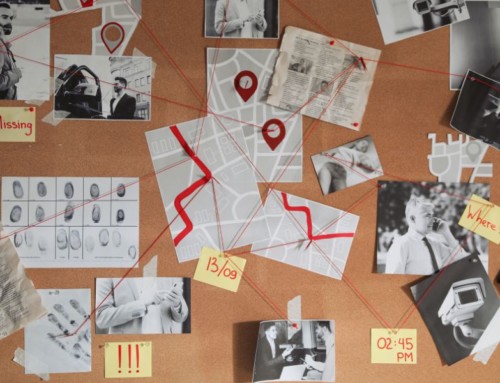
For most novels, writers can decide if they are a plotter (fully outline ahead of time) or a panster (wing it as they write without an outline). Mystery novels, however, get more complicated without an outline on hand. Even if you simply write notes to yourself about who the suspects will be and the actual villain, where you’ll drop clues, and your red herrings—that’s more helpful than not having a bird’s eye view of your mystery. But, we highly recommend a more robust outline to all mystery writers.
In this blog post, we’re discussing the importance of outlines for mysteries and the different types of outline techniques you can use. We’re also sharing a mystery outline example and a few successful mystery books you can read for inspiration.
Why Mystery Outlines Are Important
Before diving into the types of outlines you can use, let’s discuss why outlines are important when writing a mystery.
Outlines can organize your thoughts and ideas, which ensures that all the pieces of your book’s puzzle neatly fit together. They will also help you spot potential plot holes in your mystery before you have thousands of words on paper. It’s a lot harder to backtrack after completing the first draft of a mystery and fill in more details because you have to be mindful of all the clues and suspects you’ve already included.
3 Types of Mystery Outlines to Try
There are several types of outlines you can use when writing a mystery. Here are three of the most common types used:
1. The Three-Act Structure
The three-act structure—the setup, confrontation, and resolution—is a popular outline used in many different genres, including mysteries.
2. The Hero’s Journey
The hero’s journey is a narrative structure that is typically used in fantasy and adventure stories, but it can also be used for mysteries. For this outline, you’ll follow the hero’s journey (protagonist) through the call to adventure, the initiation, and the return.
3. The Snowflake Method
The Snowflake Method is a popular outlining technique that begins with a simple idea that you then expand into a detailed plot.
This outline technique starts with a one-sentence summary, then you gradually add more details until you reach a complete outline.
Mystery Outline Example
The “Whodunit” technique is one of the most popular and widely used mystery outlines. This outline is a classic mystery formula that includes a crime, the suspects, the clues, and the reveal.
Let’s break down each aspect of the “Whodunit” outline, so you can better understand how it works.
The Crime
The crime is the event that will set your mystery in motion. This is what your protagonist, hero, or detective needs to solve. Your book’s crime can be a murder, theft, missing person, or any other type of scenario that needs solving.
The Suspects
Your suspects are the characters who possibly committed the crime. A classic mystery will often have several suspects, each with a motive and an opportunity to commit the crime.
Remember the board game, Clue? Each player’s character had a possible location, weapon, and motive to commit the crime. Think of that same approach when it comes to creating characters and adding suspects to your mystery.
Not all your suspects are actually guilty, but you don’t want the real culprit to be immediately obvious to readers.
The Clues
Clues are the pieces of evidence that your protagonist will find and use to solve the crime. These nuggets of information will help the main character piece together what happened—or lead them astray if you use the red herring technique—and who is responsible for the crime.
Not all clues need to be the same. They can be witness statements, physical evidence, or anything else that helps move the story forward.
The Reveal
The reveal is the moment when your main character solves the mystery. It should be a satisfying and surprising resolution that ties up all loose ends for your readers. It should be well-supported by the clues you sprinkled along the way and the logic of the story. You want your readers to feel that the solution was earned by the protagonist and not simply pulled out of thin air.
3 Ways to Take Your Mystery’s Outline and Write a First Draft
In this section, we’re sharing some tips on how to take your outline and turn it into a complete mystery novel.
1. Fill in the Details
Your outline will give you a general overview of your story, but you’ll have to fill in the details when you write your first draft. These details include dialogue, setting descriptions,you’re your character development.
2. Keep the Pace Moving
Mystery novels have to keep the reader engaged and on their toes, so they stay hooked until the very end. Keep the pace of your story moving by including clues, red herrings, twists and turns. Also, avoid long periods of exposition.
3. Edit, Edit, Edit
Once you’ve finished your first draft, you’ll need to revise and edit your work. This means you’ll need to evaluate the pacing, plot, and character development, but also you’ll need to check for spelling and grammar errors.
Mystery Books to Read for Inspiration
If you’re looking for inspiration for your own mystery novel, we always recommend reading other successful books in the same genre. Here are a few titles to add to your reading list:
The Girl with the Dragon Tattoo by Stieg Larsson
This international bestseller follows journalist Mikael Blomkvist and a computer hacker, Lisbeth Salander, as they investigate the dark secrets of a wealthy family.
Gone Girl by Gillian Flynn
This psychological thriller follows Amy Dunne’s disappearance and the investigation into her husband Nick’s involvement.
Verity by Colleen Hoover
A psychological thriller, Verity, tells the story of a struggling writer, Lowen Ashleigh, who takes a ghostwriting job for successful author, Verity Crawford, who is incapacitated from an accident. Lowen begins to uncover dark and disturbing secrets about the author’s past and present.
Discover more from Mill City Press
Subscribe to get the latest posts sent to your email.








Leave A Comment